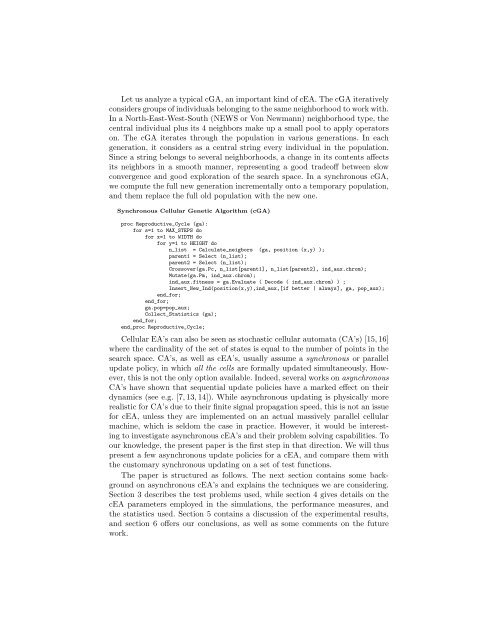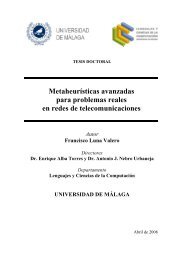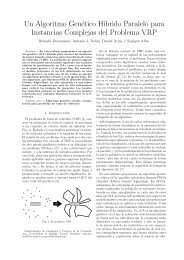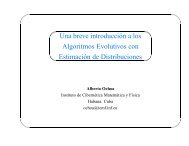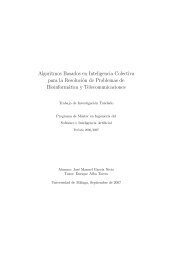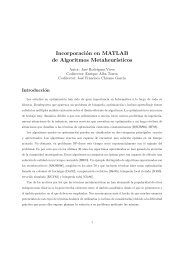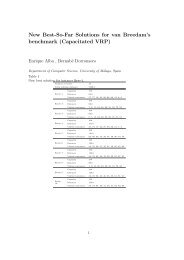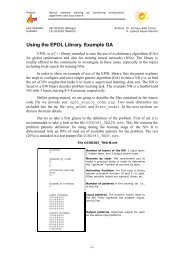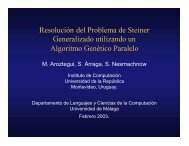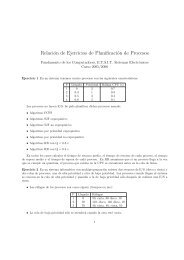Comparing Synchronous and Asynchronous Cellular Genetic ... - NEO
Comparing Synchronous and Asynchronous Cellular Genetic ... - NEO
Comparing Synchronous and Asynchronous Cellular Genetic ... - NEO
You also want an ePaper? Increase the reach of your titles
YUMPU automatically turns print PDFs into web optimized ePapers that Google loves.
Let us analyze a typical cGA, an important kind of cEA. The cGA iteratively<br />
considers groups of individuals belonging to the same neighborhood to work with.<br />
In a North-East-West-South (NEWS or Von Newmann) neighborhood type, the<br />
central individual plus its 4 neighbors make up a small pool to apply operators<br />
on. The cGA iterates through the population in various generations. In each<br />
generation, it considers as a central string every individual in the population.<br />
Since a string belongs to several neighborhoods, a change in its contents affects<br />
its neighbors in a smooth manner, representing a good tradeoff between slow<br />
convergence <strong>and</strong> good exploration of the search space. In a synchronous cGA,<br />
we compute the full new generation incrementally onto a temporary population,<br />
<strong>and</strong> them replace the full old population with the new one.<br />
<strong>Synchronous</strong> <strong>Cellular</strong> <strong>Genetic</strong> Algorithm (cGA)<br />
proc Reproductive_Cycle (ga):<br />
for s=1 to MAX_STEPS do<br />
for x=1 to WIDTH do<br />
for y=1 to HEIGHT do<br />
n_list = Calculate_neigbors (ga, position (x,y) );<br />
parent1 = Select (n_list);<br />
parent2 = Select (n_list);<br />
Crossover(ga.Pc, n_list[parent1], n_list[parent2], ind_aux.chrom);<br />
Mutate(ga.Pm, ind_aux.chrom);<br />
ind_aux.fitness = ga.Evaluate ( Decode ( ind_aux.chrom) ) ;<br />
Insert_New_Ind(position(x,y),ind_aux,[if better | always], ga, pop_aux);<br />
end_for;<br />
end_for;<br />
ga.pop=pop_aux;<br />
Collect_Statistics (ga);<br />
end_for;<br />
end_proc Reproductive_Cycle;<br />
<strong>Cellular</strong> EA’s can also be seen as stochastic cellular automata (CA’s) [15, 16]<br />
where the cardinality of the set of states is equal to the number of points in the<br />
search space. CA’s, as well as cEA’s, usually assume a synchronous or parallel<br />
update policy, in which all the cells are formally updated simultaneously. However,<br />
this is not the only option available. Indeed, several works on asynchronous<br />
CA’s have shown that sequential update policies have a marked effect on their<br />
dynamics (see e.g. [7, 13, 14]). While asynchronous updating is physically more<br />
realistic for CA’s due to their finite signal propagation speed, this is not an issue<br />
for cEA, unless they are implemented on an actual massively parallel cellular<br />
machine, which is seldom the case in practice. However, it would be interesting<br />
to investigate asynchronous cEA’s <strong>and</strong> their problem solving capabilities. To<br />
our knowledge, the present paper is the first step in that direction. We will thus<br />
present a few asynchronous update policies for a cEA, <strong>and</strong> compare them with<br />
the customary synchronous updating on a set of test functions.<br />
The paper is structured as follows. The next section contains some background<br />
on asynchronous cEA’s <strong>and</strong> explains the techniques we are considering.<br />
Section 3 describes the test problems used, while section 4 gives details on the<br />
cEA parameters employed in the simulations, the performance measures, <strong>and</strong><br />
the statistics used. Section 5 contains a discussion of the experimental results,<br />
<strong>and</strong> section 6 offers our conclusions, as well as some comments on the future<br />
work.


